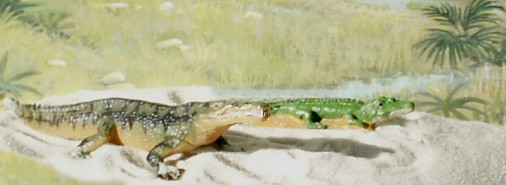LATE TRIASSIC NORIAN AGE
In the Western United States, the Chinle formation and Dockum group includes a rich record of Late Triassic animals and plants. Updated 091612

Dinosaurs are a minor component of the fauna. Archosaurs fill most of the roles later occupied by dinosaurs. Their extinction presented opportunities for dinosaurs.
The Placerias Quarry of northeastern Arizona is one of the most diverse Triassic vertebrate fossil localities in the world. Climatic models for the Chinle Formation are consistent with the hypothesis that seasonal droughts The apex predator is Postosuchus. Aetosaurs include Paratypothorax and Desmatosuchus. Coelophysids and cynodonts are present. Phytosaurs are rare.The climate was arid in northen limits of the Chinle and more humid in the south. The terrain of flood plains and braided rivers supported amphibians and phytosaurs. The vegitation was varied and rich along the rivers it inlcuded ferns, lycopsids and horsetails. Petrified tree trunks attest to the present of tall trees in stands or even forests. The Araucaria grew up to 60 feet high had thin bark and extensive roots. This is interesting given the abscence of sauropodamorphs the only potential high browsers. Cycads, cycadiods and ginkgoes are grow nearby in drier areas. Dry adapted confers must have grown in other areas.

The phytosaur Anghistorhinus may be the same as Rutiodon, one of the biggest must have been a top predator much like the large crocodiles of Australia and South America feeding on a variety of other reptiles. The small amphibian Apachesaurus and other metoposaurs are present.

Phytosaurs fossils have also been referred to Parasuchus and Leotosuchus. Phytosaurs are found in the northern part of Pangaea, Laurasia. They are not closely related to alligators or crocodiles but resembled them superficially except that the nostrils are set in front of the eyes rather than at the end of the snout. Teeth have been found in the petrified forest in Arizona. The ancestors of alligators were evolving in the southern part of Pangaea, Gondwanaland. Perhaps the droughts were less extreme there or they had not become as committed to an aquatic life style as they would later. Either way they survived the Triassic but phytosaurs didn't.
